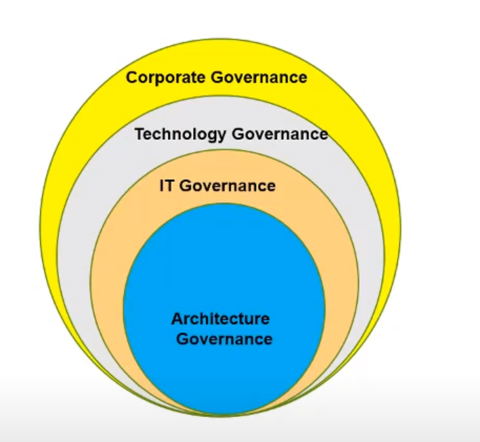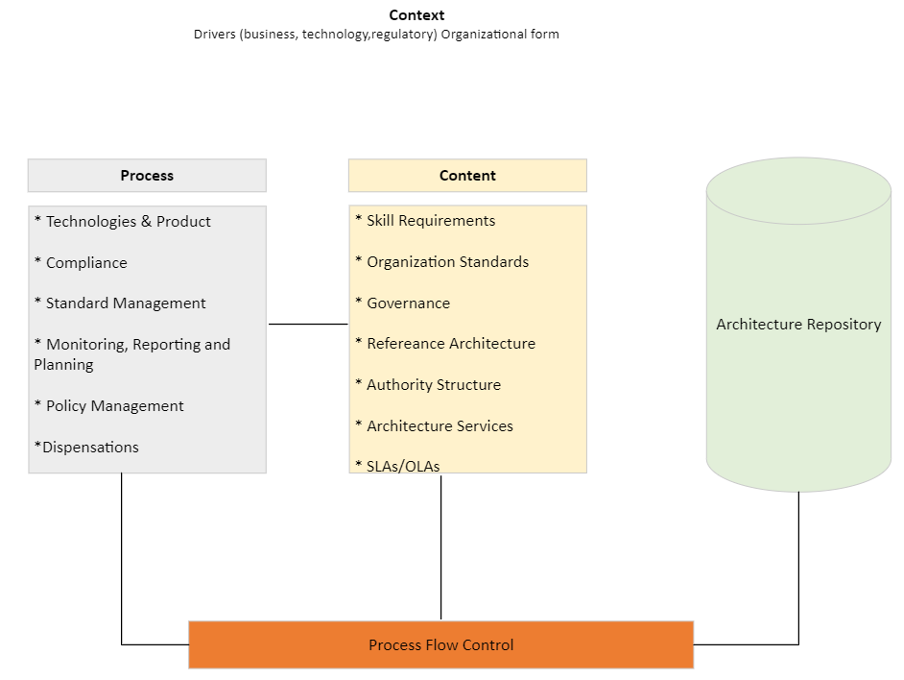What is architecture governance?
Governance is a system of rules, practices, and processes by which a company is controlled and directed. It is less about deliberate control and strict adherence to rules, and more about the effective usage of resources to achieve an organization’s strategic objectives. Architecture governance is a practice by which enterprise architecture and other architectures are controlled and managed at an enterprise-wide level.
Architecture governance includes the following:
- Arrangement of controls over the design and monitoring of all architectural components and activities, to ensure the effective implementation and changes to the architecture within the organization.
- Arrangement of controls ensures compliance with internal and external standards and regulatory obligations.
- Applying best practices that ensure accountability to a clearly identified stakeholder community, both inside and outside the organization.
- Establishing processes that support effective management of the above processes within agreed parameters.
With No Enterprise Architecture (EA) governance, an organization is likely to tumble into a web of non-standardized processes and technology, bad product purchases or development, and monolithic architectures. These habits will inevitably have a long-term financial and operational impact, creating collaboration and standardization issues increasingly difficult to correct at an enterprise level.
With a proper governance framework in place, an operation can not only achieve significant cost savings but also get the benefit of Architectural coherence with streamlined compliance. Additionally, it can get proper visibility about where improvements are required and apply true best practices. Finally, it improves the clarity of roles and responsibilities through management oversight.
What are the main characteristics of governance?
There are 6 main characteristics of governance as per TOGAF specification, which are
Discipline: All involved stakeholders will have a commitment to follow and stick to the procedures prepared by the organization.
Transparency: All the decisions are guided by reasoning, carefully evaluated, and agreed upon by different architecture disciplines.
Independence: All processes, decision-making, and mechanisms used will be established so as to minimize or avoid potential conflict of interest.
Accountability: Identifiable groups within the organization- e.g., governance boards who take actions or make decisions- are authorized and accountable for their actions.
Responsibility: Each contracted party is required to act responsibly to the organization and its classes.
Fairness: No unfair advantage to any one particular party
Where does architecture governance stand in governance hierarchy?
Architecture governance typically operates within the hierarchy of governance structures which particularly in the larger enterprise, can include the following as distinct domains with their own disciplines and processes as illustrated in fig-1 of governance hierarchy:

Figure 1: Governance Hierarchy
Each of these domains of governance may exist in multiple geographic levels- global, regional, and local- within the overall enterprise.
Corporate governance is a very broad subject and is beyond enterprise architecture framework. Corporate governance in the business context refers to the system of rules, practices, and processes by which companies are governed.
Technology governance is a key capability, requirement, and resource for most organizations because of the pervasiveness of technology across the organizational spectrum. Technology governance controls how an organization utilizes technology in the development, research, production of its goods and services.
IT governance provides the framework and structure that links IT resources and information to enterprise goals and strategies. Furthermore, IT governance apply best practices for planning, acquiring, implementing, and monitoring IT performance, to ensure that the enterprise’s IT assets support its business objectives.
What are the main concepts that make up an Architecture Governance Framework?
Figure-2 illustrates the generic and conceptual architecture governance framework which can be adapted by the existing governance environment. It helps to identify effective processes and organizational structure so that the business responsibilities can be elucidated, communicated, and managed.

Figure 2: Architecture governance framework- conceptual structure
Processes are mainly outlined by business architecture practice based upon the best practices and previous learnings such as compliance policies, monitoring, reporting, and planning, dispensations (exceptions), etc. Contents of these charted processes are stored in an architecture library which is being referred to at various stages of a project.
The major information governance repository contains is related to reference data, process status, and audit information.
- Reference Data: Could be TOGAF governance guidelines or standards, governance procedures
- Process Status: a record of all information regarding the state of any governance processes; examples of this include outstanding compliance requests, dispensation requests, and compliance assessment investigations.
- Audit Information: a record of all completed governance process actions.
This is used to support:
- Key decisions and responsible personnel for any architecture project that has been sanctioned by the governance process
- A reference for future architectural and supporting process developments, guidance, and precedence
The architecture board is responsible for the review and maintenance of the overall architecture and ensure whether all processes are being followed. A challenge in building governance structure is really getting your view of how your architectural organization interacts with other disciplines across the business.
In Summary, why is Architecture Governance beneficial?
- Cost optimization
- Improved Business agility
- Technology and process standardization
- Establish common understanding
- Improved business – IT alignment – operational & strategic
A final say on architecture governance:
An enterprise must embrace balanced governance, with appropriate metrics and documentation. Too structured governance leaves no room for creativity and becomes bureaucratic and slow. Unstructured governance will be free for all with no metrics or documentation which produce inconsistent results.
If you would like to learn more about BPD Zenith and what we can offer you, contact us at: https://www.bpdzenith.com/contact/




